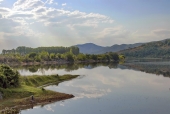
NAME OF THE LOCAL AREA
Kerkini Lake (EPAL Axioupolis)
COUNTRY
Greece
THEMATIC AREA
Geography, Biology, Geology
DESCRIPTION OF THE LOCAL AREA
Lake Kerkini is an artificial reservoir that was created in 1932, and then redeveloped in 1980, on the site of what was previously an extremely extensive marshland. It is located 80 km from Thessaloniki and 35 km from Serres.
Lake Kerkini is now one of, if not the, premier birding site in Greece, and, as it is situated along the migratory flyway for migratory birds en route to the Aegean Sea, the Balkan region, the Black Sea, the Hungarian steppes and beyond it experiences an interesting migration.
In the flat and semi-mountainous area, important hydrobiospheres are developing which are of great international significance and acceptance. The most essential hydrobiosphere is the one in Kerkini lake. It is a miracle of nature which came about by man's technical intervention on the natural characteristics of Strymon river. The water extent, which varies from time to time from 54 Km2 to 72 Km2, works out to be useful in two ways: as a technical work of great agricultural utility and as a hydrobiosphere for thousands of water fowls.
This wonderful biosphere is recouped by the International Convention of Ramsar and presents numerous admirable elements. Thousands of birds, both rare and protected, riverside forests, water-lilies in a large area, fish variety and fantastic panoramic view from the mountains of Belasica and Krousia give it a characteristic tone. Actually the lake hosts 227 kinds of birds, especially non-migrants. 76 of them are recorded in the National Red Catalogue, while at least 31 of them are protected by EEC's Directive concerning wild life. What makes an exceptional presence is the buffalo's herd in the area, plus the one of the jackelo in the area of Kerkini lake. In the surrounding area of Kerkini lake there are at least 10 amphibian species (frogs, salamanders, tritons), five snail species, 19 reptile species (lizards, snakes, turtles) and a great variety of insects which play an important part in the food chain and contribute towards the biological resources of the lake.
